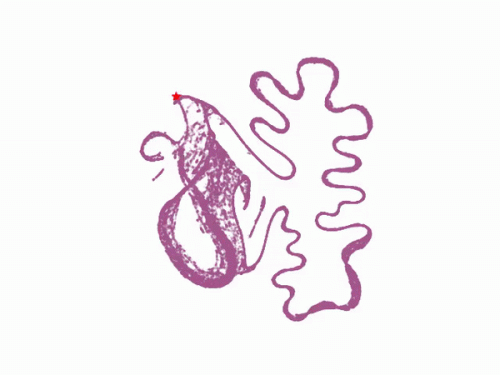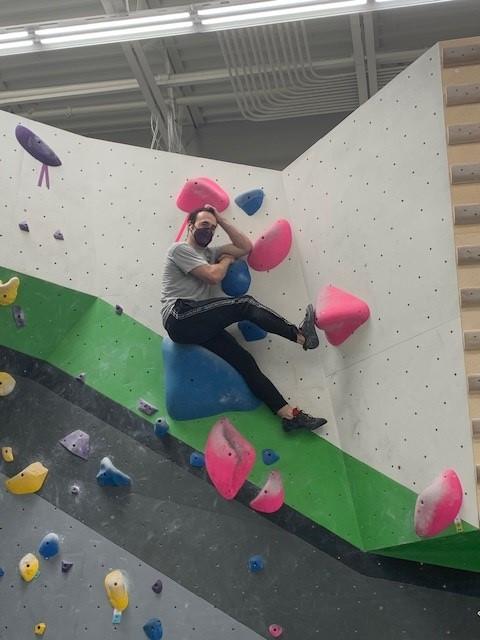
Miles Martinez
Miles is a 4th year ECE Ph.D. candidate with the CNAP program. When he's not rock climbing and finding the best coffee in Durham, he's studying how birds learn to sing.
Trainee Spotlight is a series of interviews from the Duke Institute for Brain Sciences that showcases the science and lives of the people behind the lab coats studying the brain at Duke. Want to suggest someone for the series or nominate yourself? Email the DIBS Director of Communications Dan Vahaba.
This interview has been edited for length and clarity.
I. Kjaerulff: How did you get interested in science? What brought you from there to now?
M. Martinez: I was lucky enough to start doing science in high school. I grew up right next to UC Berkeley, and there happened to be a grad student in a vision science lab who was putting on a summer internship. What really ended up drawing me to science through that experience was the people I was working with. They were absolutely wonderful. I'm still friends with the grad student who ran that program.
It has always been the people I've been working with that have drawn me to science. There are a lot of incredible people who are passionate and interested in everything that they're doing. That's a beautiful space to be in. As I have followed along, I've developed a love for the type of learning research is itself. The chance to unravel a little bit of mystery is the second half of my love for science.
IK: What interested you in joining CNAP instead of a more traditional Ph.D.-granting program?
MM: Not many people know about CNAP. It's one of those secrets that I wish wasn't really a secret. One of the reasons in joining was that I would have to make as few quick decisions as possible.
I was considering your traditional psychology degree, but I wasn't 100% sure, so, I was really attracted to the rotation system. It gives me a lot of flexibility to figure out myself, my own interests, and also how I collaborate with the professors in the labs as well. That was part of it, but the big part was that I could also rotate through departments.
I was interested in doing things that are more computation-oriented. Just being able to have the option to decide what department I go into eventually was another huge draw. I would say the last huge draw were just the people associated with DIBS and the CCN. It's just a really nice community. They're all wonderful trainees and the professors are incredibly supportive. It's just a very positive environment.
IK: What is it that you research, in a few sentences?
MM: I study songbirds. I try to understand how birds learn to sing, and more generally how we learn by watching other people, because that's what the birds are doing. They're learning from a skilled tutor how to perform this super complicated task. So, I both develop and then use methods for understanding how these birds learn to sing.
IK: What’s the broad impact of studying how songbirds learn to communicate?

MM: There are a lot of structures in the bird brain that are analogous to the kind of learning architecture that's in our brains. By learning about the songbird system, both on a neural and behavioral level, we can help understand ourselves better and our own learning processes, and potentially even design learning processes that can help us learn new actions better.
IK: You work at the intersection between cognitive neuroscience and electrical engineering. How does song-learning neuroscience intersects other STEM fields?
MM: Neuroscience has to be intersectional. By its nature, there are so many different aspects that you need to understand behavior and the underlying neural architecture. You need the methods to tie those two together and to investigate each individually, so there's a computational aspect. There is the hardware development side—actually creating new microscopes that we can use to look in the brains of these animals while they're naturally singing. There's the neuroscience aspect, which is being able to probe and understand the underlying neural circuitry. There are also deeper biological aspects of this work. And then there's a behavioral aspect, which is what I'm focusing on right now. We've looked with very simple measures in the past that have limited our ability to understand sound learning, and I'm really hoping to push that aspect forward. It's an intersection between countless different STEM fields.
IK: We caught your research talk the other day. You seem to really like variance. What's so interesting about chaotic data?
MM: One of the things that's cool is that it's really hard to understand. Just the challenge behind unraveling that difficult data is exciting on its own. There's so much depth and structure in chaotic data. It's so informative about what's actually happening in these natural systems.
In that talk, I was talking about variance in the songs that the birds are producing. Presumably, when the birds are producing different variants—these chaotic data that I was talking about—they're actively trying to test out new types of their song. Looking at that complex structure tells us about the types of strategies that they're using to learn. So, it's both the challenge and the promise of the structure that's underneath all of that chaos.
IK: You went from the West Coast to Brown, and now to Duke. What are you looking to do after your time here?
MM: When I started, I was very much on the fence about academia versus industry, as I think most grad students are these days. But again, as I've developed that love for what I'm doing, beyond just the love of the people who I'm working with, I've really started to want to stay in research and continue to do this kind of research. I would love to do something that would let me continue to ask these kinds of interesting questions, but also would let me mentor and teach other neuroscientists. The people who got me into this, that's what they were doing, and I really want to help push that forward.

IK: For now, what do you love to do outside of your work around Duke?
MM: One of my favorite things to do is just go to a coffee shop and hang out, try new food and things. There's really good coffee in the area. Cocoa Cinnamon is a classic. I also enjoy climbing and going outside to walk my dog.
IK: What's the number-one restaurant in Durham?
MM: My favorite would have to be Rose’s Noodles Dumplings and Sweets. I love their noodles. I love their sweets. I love their dumplings. So, it’s really three for three. They have a really wonderful smash tofu salad, but I specifically say it for the pork buns. They’re delicious.
IK: What is a “pro tip” for science that you've learned during your time here?
MM: I would say, go work with people you really like. You have to like the research that you're doing, but so much of your life is working with other people, so if you're going to go somewhere to do something that you like, then make sure you're doing it with people that you like. You can always become interested in the research that you're doing if the people around you are interested in it. But if you're doing research that you like, and you don't like the people you're working with, it's just going to suck all of the life and the passion you have out of that research. Take care of yourself and enjoy the people that you work with.
If you are a Duke undergraduate, graduate, or postdoc student studying the brain and would be interested in taking part in an interview for this series or want to nominate someone, please reach out to Dan Vahaba, Director of Communications at DIBS.
